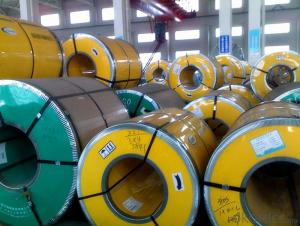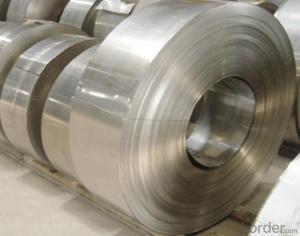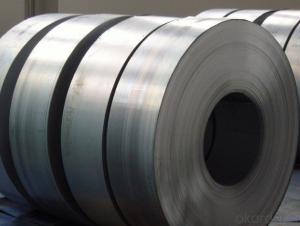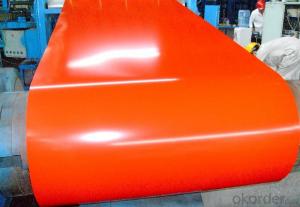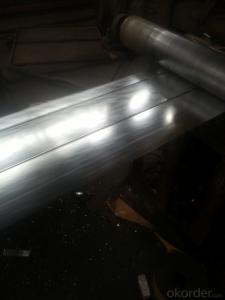Galvanized Steel Coil/Hot Dipped Galvanized Steel Strips Coil
- Loading Port:
- Tianjin
- Payment Terms:
- TT OR LC
- Min Order Qty:
- 1000 m.t.
- Supply Capability:
- 100000 m.t./month
OKorder Service Pledge
OKorder Financial Service
You Might Also Like
Galvanized Steel Coil/Hot Dipped Galvanized Steel Strips Coil Description:
Galvanized steel coil are widely used in the construction industry, as raw material for the production of corrugated panels, fencing products, drywall panel profiles, ventilation systems etc. Recommended for both outside and inside usage, galvanized steel has a high resistance to corrosion in different environments, due to a protective layer of zinc of 100 – 180 grams per square metre.
Main Features of Galvanized Steel Coil/Hot Dipped Galvanized Steel Strips Coil:
Hotdip galvanized steel coils are produced by immersing steel in a zinc bath. An appropriate galvanizing process requires a pretreatment process during which the steel passes through different baths which prepare the surface for zinc coating. In this stage, chemicals are used to clean the surface of the steel. After the chemical treatment, the steel coils pass through a bath of melted zinc at temperatures around 460 ° C. The resulting uniform coating is finished through a process of skin-passing to provide smooth and shiny appearance of the finished product. To store for a longer period, the hot-dip galvanized coils can be delivered with a final oil coating, according to the customer’s demand.
Galvanized Steel Coil/Hot Dipped Galvanized Steel Strips Coil Images:
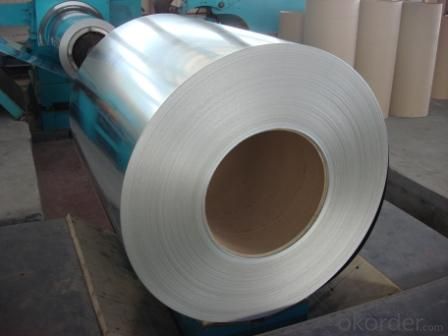
Galvanized Steel Coil/Hot Dipped Galvanized Steel Strips Coil Specifications:
Steel strips coils galvanized
Material: Q195, Q215, Q235, Q345B, SGCC, DX51D+Z
Thickness:0.75-4.5mm
Width:32-750mm
Zinc coating: 60-550g/m2
ITEM | |
Production | prime hot dipped galvanized steel strip coil |
Port | Tianjin, China |
Category | Minerals & metallurgy |
Thickness | 0.17-3.0mm |
Width | 600-1950mm |
Material Grade | SGCC,SGCH,SGCD1-SGCD3,DX51D |
Spangle | normal spangle, large spangle, small(min) spangle, zero spangle |
Technique | cold rolled,hot dipped galvanized |
Standard | ASTM,GB ,AISI,JIS,EN |
Test | With Hydraulic Testing, Eddy Current , Infrared Test |
Application | Widely used for roofs, outer walls, ovens, explosive-proof steel, electrically controlled cabinets,galvanized tube/pipe, ceiling channel, building material |
Surface | Galvanized |
Package | covered with waterproof-paper,strapped by strips. Or as customer’s requirement |
Sample | Common products, we can provide freely, for special production,we can depends on negotiation. |
MOQ | 5 tons |
Payment | 100% L/C at sight, 30% T/T in advance, and the balance against the copy of B/L or negotiation |
Delivery time | Within 10-25 days, according to quantity, asap save customer’s time |
Certificate | ISO9001:2008 |
FAQ:
Q: Are you manufacturer of trading company?
A: Yes.
- Q:What are the factors that affect the corrosion resistance of steel strips?
- The factors that affect the corrosion resistance of steel strips include the composition of the steel, the presence of impurities or alloying elements, the environment in which the steel is exposed to (such as moisture, temperature, and chemical exposure), the surface condition of the steel (such as surface finish or coatings), and the presence of any protective measures or inhibitors.
- Q:How do steel strips handle exposure to chemicals?
- Steel strips generally have good resistance to exposure to chemicals. However, the level of resistance can vary depending on the type of chemical and the specific alloy composition of the steel. Stainless steel strips, for example, are highly resistant to corrosion from many chemicals due to their high chromium content. It is always recommended to consult the chemical compatibility charts or seek expert advice to ensure the appropriate steel strip is chosen for specific chemical environments.
- Q:How are steel strips processed for flexibility?
- Steel strips undergo various manufacturing techniques and treatments to achieve flexibility. One frequently employed method is cold rolling, which involves passing the strip through room temperature rollers to decrease its thickness and enhance flexibility. This process also strengthens and hardens the steel. Moreover, after cold rolling, annealing is often carried out to further improve the strip's flexibility. This entails heating the strip to a specific temperature and gradually cooling it. By doing so, any internal stresses in the steel are relieved, allowing for easier deformation and increased flexibility. In addition, tempering can be utilized to enhance the flexibility of steel strips. This entails heating the steel to a high temperature and rapidly cooling it. Tempering aids in increasing the ductility and toughness of the steel, making it more flexible and resistant to stress-induced cracking or breaking. In certain cases, steel strips may undergo skin-pass rolling. This process involves passing the strip through rollers that gently apply pressure to the surface, resulting in a smoother and more uniform finish. Skin-pass rolling contributes to the flexibility of the steel strip by reducing surface irregularities and enhancing overall quality. In conclusion, a combination of cold rolling, annealing, tempering, and skin-pass rolling is commonly employed to process steel strips for flexibility. These techniques optimize the mechanical properties of the material, ensuring that it can be easily molded, formed, or shaped for various applications without compromising its structural integrity.
- Q:What are the common grades of steel used for strips?
- Strips used in various industries can be made from different grades of steel. These grades are selected based on the specific needs of the application, such as strength, durability, corrosion resistance, and machinability. One grade that is commonly used for strips is carbon steel, particularly low carbon steel like AISI 1008 or 1010. Low carbon steel is known for its excellent formability and weldability, making it suitable for a wide range of applications such as automotive components, construction materials, and general manufacturing. Stainless steel is another commonly used grade for strips. It is highly resistant to corrosion and oxidation, making it ideal for applications where exposure to moisture, chemicals, or extreme temperatures is expected. Common stainless steel grades used for strips include AISI 304 and 316, which offer excellent strength and corrosion resistance. High-strength low alloy (HSLA) steel is also frequently used for strips. HSLA steel combines high strength with good formability, making it suitable for applications that require both strength and flexibility. Common HSLA steel grades for strips include ASTM A572 and A1011. Furthermore, specific industries may require specialized grades of steel for certain applications. For instance, the automotive industry often relies on high-carbon steel strips to manufacture vehicle components that need high strength and wear resistance. Ultimately, the choice of steel grade depends on the specific requirements of the application. It is important to consult engineers or material experts to determine the most suitable grade of steel for a particular project.
- Q:What is the difference between galvanized and zinc-coated steel strips?
- Galvanized and zinc-coated steel strips have a similar purpose of providing corrosion resistance, but the difference lies in their manufacturing process. Galvanized steel strips are created by immersing the steel in a bath of molten zinc, resulting in a thicker coating that provides better protection. On the other hand, zinc-coated steel strips are produced by electroplating a thin layer of zinc onto the steel surface. This difference in the coating process affects the durability and longevity of the steel strips in different applications.
- Q:Are steel strips suitable for architectural applications?
- Yes, steel strips are suitable for architectural applications. Steel strips offer numerous advantages that make them suitable for architectural applications. Firstly, steel is a strong and durable material that can withstand heavy loads and extreme weather conditions. This makes it ideal for use in architectural structures such as bridges, buildings, and roofs. Additionally, steel strips are versatile and can be easily customized to meet specific design requirements. They can be rolled, bent, and shaped into various forms, allowing architects to create unique and aesthetically pleasing structures. Steel strips also offer a wide range of finishes and coatings, making them suitable for both interior and exterior applications. Moreover, steel strips are highly resistant to corrosion, rust, and fire, ensuring long-term durability and safety. They also have a high strength-to-weight ratio, which means that they can provide structural support while being lightweight. Furthermore, steel is a sustainable material that can be recycled, reducing the environmental impact of architectural projects. It is also cost-effective, as it requires minimal maintenance and has a long lifespan. In conclusion, steel strips are indeed suitable for architectural applications due to their strength, durability, versatility, resistance to corrosion and fire, sustainability, and cost-effectiveness.
- Q:Can steel strips be used in the production of heat exchangers?
- Yes, steel strips can be used in the production of heat exchangers. Steel is a commonly used material in heat exchanger manufacturing due to its excellent thermal conductivity, high strength, and durability. Steel strips can be shaped and formed into the necessary components of a heat exchanger, such as fins, tubes, or plates. These components are crucial for efficient heat transfer between fluids in a heat exchanger. Steel strips also offer corrosion resistance, making them suitable for various environments and applications. Overall, steel strips are a viable and commonly used material for the production of heat exchangers.
- Q:What are the different surface plating methods for steel strips?
- There are several different surface plating methods for steel strips, including electroplating, hot-dip galvanizing, electroless plating, and mechanical plating.
- Q:Can steel strips be used in the production of furniture?
- Yes, steel strips can be used in the production of furniture. They are commonly used to provide structural support, reinforcement, or decorative elements in various types of furniture such as chairs, tables, shelves, and cabinets. Steel strips offer durability, strength, and versatility, making them a popular choice for modern and industrial-style furniture designs.
- Q:What is the thermal conductivity of a steel strip?
- The thermal conductivity of a steel strip can vary depending on the specific type and composition of the steel, but generally, it is around 15-50 W/mK (watts per meter-kelvin).
1. Manufacturer Overview |
|
|---|---|
| Location | |
| Year Established | |
| Annual Output Value | |
| Main Markets | |
| Company Certifications | |
2. Manufacturer Certificates |
|
|---|---|
| a) Certification Name | |
| Range | |
| Reference | |
| Validity Period | |
3. Manufacturer Capability |
|
|---|---|
| a)Trade Capacity | |
| Nearest Port | |
| Export Percentage | |
| No.of Employees in Trade Department | |
| Language Spoken: | |
| b)Factory Information | |
| Factory Size: | |
| No. of Production Lines | |
| Contract Manufacturing | |
| Product Price Range | |
Send your message to us
Galvanized Steel Coil/Hot Dipped Galvanized Steel Strips Coil
- Loading Port:
- Tianjin
- Payment Terms:
- TT OR LC
- Min Order Qty:
- 1000 m.t.
- Supply Capability:
- 100000 m.t./month
OKorder Service Pledge
OKorder Financial Service
Similar products
New products
Hot products
Related keywords




















